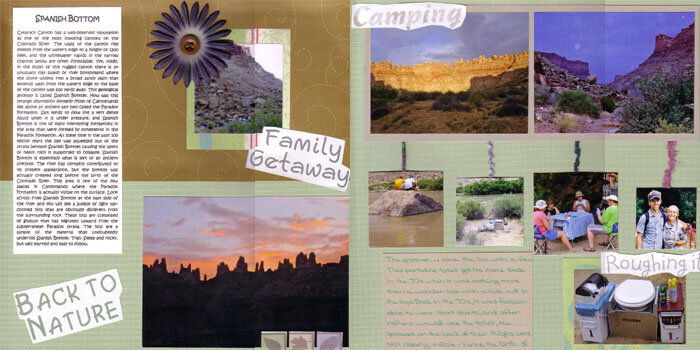
Cheers
Be the first to cheer this project!

Be the first to cheer this project!
 Give a Cheer
Give a Cheer
Another Utah LO - This was our second night's camp site and by far the best. We had a fantastic view of the Doll House (where we hiked to) and a nice little eddy on the side of the river so we could wade out waist deep without dealing with the river's current. Typed journaling from: http://www.utahtrails.com/SpanishBottom.html.
Journaling: (Typed) Cataract Canyon has a well-deserved reputation as one of the most imposing canyons on the Colorado River. The walls of the canyon rise steeply from the water's edge to a height of 1200 feet, and the whitewater rapids in the narrow channel below are often formidable. Yet, oddly, in the midst of this rugged canyon there is an unusually flat swath of river bottomland where the shore widens into a broad sandy plain that extends west from the water's edge to the base of the canyon wall 600 yards away. This geological anomaly is called Spanish Bottom. How was this strange depression formed - Most of Canyonlands lies above an ancient salt bed called the Paradox Formation. Salt tends to flow like a very dense liquid when it is under pressure, and Spanish Bottom is one of many interesting formations in the area that were formed by movements in the Paradox Formation. At some time in the past 100 million years the salt was squeezed out of the strata beneath Spanish Bottom causing the layers of heavy rock it supported to collapse. Spanish Bottom is essentially what is left of an ancient sinkhole. The river has certainly contributed to its present appearance, but the bottom was actually created long before the birth of the Colorado River. This area is one of the few places in Canyonlands where the Paradox Formation is actually visible on the surface. Look across from Spanish Bottom at the east side of the river and you will see a jumble of light tan-colored hills that are obviously different from the surrounding rock. These hills are composed of gypsum that has migrated upward from the subterranean Paradox strata. The hills are a sample of the material that undoubtedly underlies Spanish Bottom. Trail: Steep and rocky, but well marked and easy to follow. (Hand-written) The groover...aka the loo with a view. This portable toliet got its name back in the 70s when it was nothing more than a wooden box with a hole cut in the top. Back in the 70s, it was fashionable to wear short shorts, and after rafters would use the toliet, the grooves on the back of their thighs were stll clearly visible - hence the birth of "THE GROOVER!"
No products have been added to this project.
Thanks for spreading positivity!